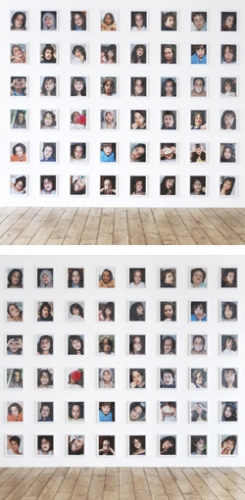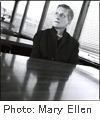On This is Me, This is You
Text: Matsuura Naomi
This is Me, This is You consists of portraits of a young girl shot over a period of about two years. The photos were taken two at a time using a point-and-shoot camera, and put together with the idea of expressing the range of the young girl’s identity. A total of 48 pairs of photographs, the first shot then another taken a few seconds later, are arranged in grid fashion on facing walls. The huge eyes of the subject mesmerize the viewer, and standing between the two walls one finds one’s gaze at some point moving back and forth, unconsciously comparing, as if experiencing the artist’s line of sight, the rhythm of her photograph-taking.
 This is Me, This is You, 1998-2000
This is Me, This is You, 1998-2000Installation of 96 C-type prints
in paired panels of 48 each
shown at Rat Hole Gallery, Tokyo (2008)
“As the photographs progressed, I was reminded of something my niece used to say when she was little, and that’s how I got the title. She would look at a picture with me, for example, and in the picture, say there is a rabbit and a flower. She would point to the rabbit and say ‘Roni, this is you.’ Then, she would point to the flower and say ‘This is me.’ That’s how I got the title. It was a fascinating way of finding out who you are, identifying yourself, and establishing relationships with others. Portraiture seems to me a meaningful form, so I keep coming back to it. This is Me, This is You is not a portrait of Georgia, it’s a portrait of someone discovering herself. Girls try on their identities at a certain age, go through a lot of testing and looking at themselves. She would change her clothes several times a day, change her hair. Cabinet of, (with the clown), is a portrait in the sense more of a collective identity, not an individual.”
The identities of people and objects are in fact highly complex, and cannot be summed up succinctly. If a thing has an obvious, one-dimensional identity, this causes people to lose interest, and it becomes exclusive. Conversely, a thing that is multidimensional and not easily understood is alluring in its very ambiguity.
“I’m attracted to things we can never fully understand. I think that’s where my interest in water comes from. We seem to know everything there is to know about water, but in reality we don’t. Water may be just water, but it exists in its relationship to other things, and is constantly changing to suit. The same goes for glass. I find it very paradoxical to have solid matter and complete transparency. I somehow can’t accept that. So I always look again, trying to work it out: it’s almost like there is some secret to the whole thing that I’m not still clear about.”
The drawing that Horn does every day forms the foundation of her diverse practice. This does not simply mean the act of drawing: the process of cutting what she draws, or the photographs she takes, and taking time to edit them into a composition that satisfies her is also important. In her photographic installations as well, the recomposition typical of Horn’s drawing element is closely related to how she takes the photos, how she chooses them, the way she cuts out the images, and the layout.
“I don’t consider myself a photographer. Because I can’t reduce my interests purely to the photograph. There is always an architectural (sculptural) and drawing element to the way I work with photography. By an architectural element I mean using architecture to split or double the experience of the work. Some of the water pieces are installed through a building, so you go from a room to room experiencing it like the flow of a river.”
The artist explains that architectural element from a different perspective: that of dependence on site. Her work is portable, but site dependent. Some works need a space with two opposing walls, others at least two rooms. There are loose parameters that allow the work to be, but these are not exclusive as in the case of site-specific works. This architectural dimension was also a consideration when choosing This is Me, This is You for her recent Japanese solo show.
The Rat Hole Gallery, surrounded by three white walls and a large glass wall on one side, also made the display of another work possible: a cast glass sculpture requiring a space with natural light. Because the sides of the piece are not polished, the viewer only sees the piercing transparency of the glass, and the opacity that creates a mirror effect, when close enough to look down on the piece from directly above. One notices sensational, breathtaking differences in the experience of the work depending on the angle and distance at which it is viewed. The glass also takes on a different aspect according to how much light enters.
“What’s important in all my works is what happens to the viewer between the first and second time they look. Nothing is ever the same, nothing is simply what you thought it was.That’s this idea of trying to make the work, the experience of the work the content of the work.”
The best way to get up close and personal with two-dimensional works of art may well be through a book. The artist’s book This is Me, This is You comprises two books joined back to back. It is constructed so that the images circulate endlessly, and there is no text.
“Books have a number of different qualities that I’m drawn to. In This is Me, This is You the circular concept and creating an experience very close to the installation were important. One also experiences the delay of a few moments between seeing the first set of portraits, and the second.”
This is Me, This is You contains many of the important elements of Roni Horn’s art practice: identity, pairs, portraits, drawings, architectural (sculptural) qualities, books.
“I think as I spend more time with it, I become more interested in this piece. It’s a work that’s becoming more important to me.”
2008.9.1

Roni Horn
Born 1955 in New York, Horn has been working across a range of different media and showing internationally since the early 1980s. She is currently based in New York and Iceland. Her first exhibition in Japan in five years, This is Me, This is You, was held summer 2008 at Rat Hole Gallery (Tokyo). A mid-career retrospective of her work was held at the Tate Modern in February 2009, which will travel to the Whitney Museum of American Art in October 2009.
